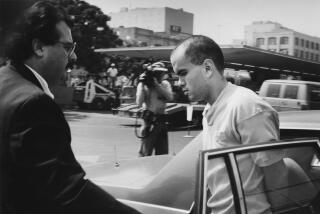Skinhead Told Police He Held Girl in Slaying
- Share via
Skinhead gang member Michael Bridgeford admitted during a police interview that he held down a 17-year-old girl while a fellow gang member slit her throat and stabbed her in the face during a slaying inside a motel bathroom four years ago.
“I didn’t think it was going to happen, you know,” Bridgeford told a detective during the interview. “But the next thing you know, it was happening.... She was flipping out. I had to hold her down, you know.”
Ventura County prosecutors played the tape-recorded interview Wednesday during the first day of testimony in Bridgeford’s murder trial, providing jurors with a candid, gruesome and at times tearful account of the 1998 slaying of Ventura teenager Nichole Hendrix.
Bridgeford, 26, of Oxnard, faces a possible sentence of life in prison if convicted of first-degree murder and allegations that Hendrix’s killing occurred during a kidnapping and robbery at the City Center Motel in Ventura.
Bridgeford is one of three gang members or associates charged in connection with the slaying, which he blamed on accomplices David Ziesmer, 30, and Bridget Callahan, 31, during his June 2000 interview with authorities.
According to Bridgeford’s statement, Callahan drugged Hendrix on Oct. 15, 1998, and rented the motel room so they could sell stolen stereo equipment in the girl’s possession to raise bail money for another gang associate arrested earlier that evening.
On the tape, Bridgeford can be heard sobbing after he described how Ziesmer grabbed Hendrix when she awoke from her drugged stupor, pulled her into the bathroom and announced that “she had to go” because he feared she would report them to law enforcement.
Bridgeford told the detective that he held Hendrix, who was fighting for her life, after Ziesmer began stabbing her with a pocketknife. Bridgeford said he did so out of allegiance to his “homeboy” and because he feared guests at the motel would hear her screams and call the police. The two skinheads had been paroled from state prison just days before the slaying.
After Hendrix died, Bridgeford told the detective, the three defendants cleaned the motel room, wrapped the body in sheets and placed it in the bed of a pickup truck. He said they later forced the body into a garbage can, filled it with wet cement and arranged for it to be dumped by other gang associates.
Hendrix’s skeletal remains were found six months later in the backcountry north of Ojai, and an investigation eventually led sheriff’s detectives to Callahan, Bridgeford and Ziesmer.
The three were indicted in August 2000. Callahan was tried and convicted last fall, but she recently won a bid for a new trial. Ziesmer’s case is expected to come to trial later this year, and prosecutors are seeking the death penalty for him.
During Wednesday’s court proceedings, defense attorney Steve Powell questioned Sgt. Michael Powers about the Bridgeford interview. Powell specifically focused on his client’s descriptions of the killing as unexpected and nightmarish. “I wake up in cold [expletive] sweats about that girl,” Bridgeford told Powers.
During the court testimony, Bridgeford sat at the defense table. He wore a dark green dress shirt, his chin occasionally resting in his hand and obscuring a large, white supremacist tattoo on his right cheek.
According to Powers’ testimony, Bridgeford wrote a letter of apology to Hendrix’s mother, Shelly Holland, after the interview. In the letter, he states: “I want you to know I did not kill your daughter ... on that night I was just scared. I wish I could go back, but can’t ... I’m truly sorry for what happened.”
More to Read
Sign up for Essential California
The most important California stories and recommendations in your inbox every morning.
You may occasionally receive promotional content from the Los Angeles Times.










